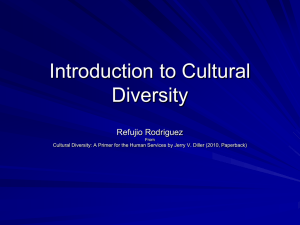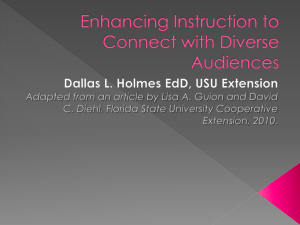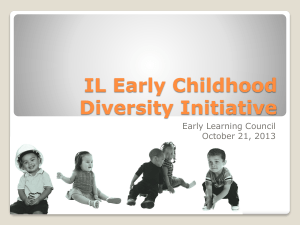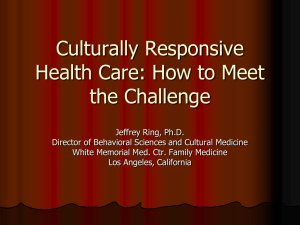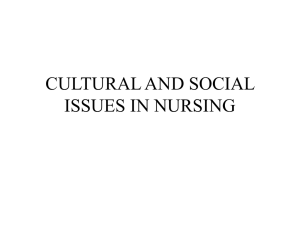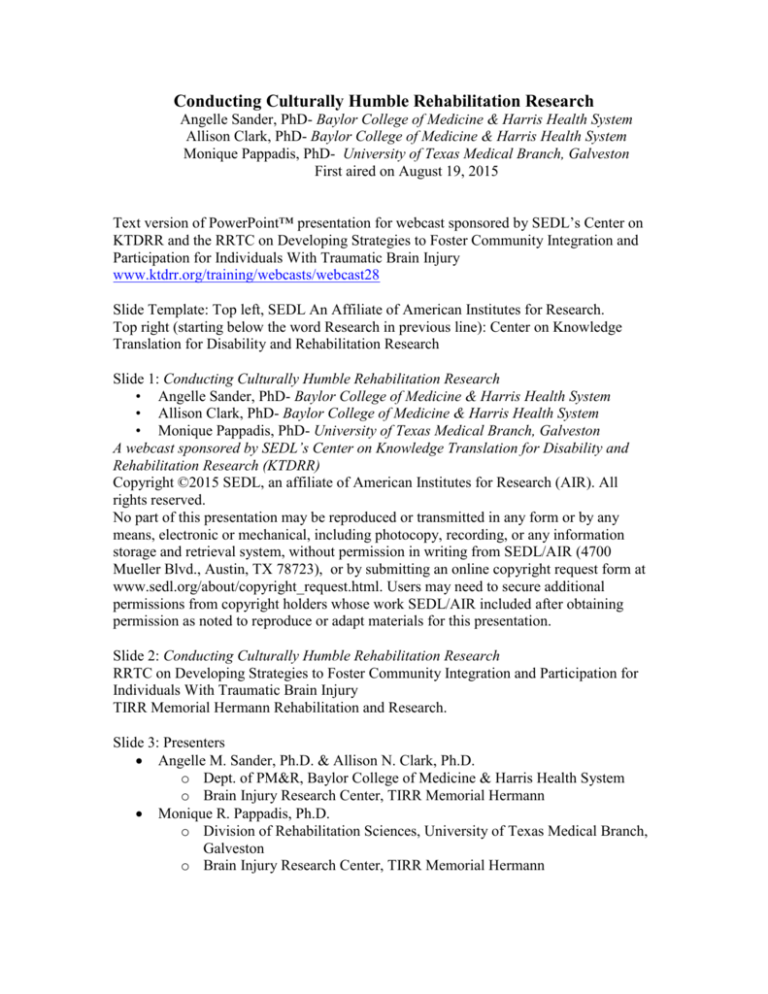
Conducting Culturally Humble Rehabilitation Research
Angelle Sander, PhD- Baylor College of Medicine & Harris Health System
Allison Clark, PhD- Baylor College of Medicine & Harris Health System
Monique Pappadis, PhD- University of Texas Medical Branch, Galveston
First aired on August 19, 2015
Text version of PowerPoint™ presentation for webcast sponsored by SEDL’s Center on
KTDRR and the RRTC on Developing Strategies to Foster Community Integration and
Participation for Individuals With Traumatic Brain Injury
www.ktdrr.org/training/webcasts/webcast28
Slide Template: Top left, SEDL An Affiliate of American Institutes for Research.
Top right (starting below the word Research in previous line): Center on Knowledge
Translation for Disability and Rehabilitation Research
Slide 1: Conducting Culturally Humble Rehabilitation Research
• Angelle Sander, PhD- Baylor College of Medicine & Harris Health System
• Allison Clark, PhD- Baylor College of Medicine & Harris Health System
• Monique Pappadis, PhD- University of Texas Medical Branch, Galveston
A webcast sponsored by SEDL’s Center on Knowledge Translation for Disability and
Rehabilitation Research (KTDRR)
Copyright ©2015 SEDL, an affiliate of American Institutes for Research (AIR). All
rights reserved.
No part of this presentation may be reproduced or transmitted in any form or by any
means, electronic or mechanical, including photocopy, recording, or any information
storage and retrieval system, without permission in writing from SEDL/AIR (4700
Mueller Blvd., Austin, TX 78723), or by submitting an online copyright request form at
www.sedl.org/about/copyright_request.html. Users may need to secure additional
permissions from copyright holders whose work SEDL/AIR included after obtaining
permission as noted to reproduce or adapt materials for this presentation.
Slide 2: Conducting Culturally Humble Rehabilitation Research
RRTC on Developing Strategies to Foster Community Integration and Participation for
Individuals With Traumatic Brain Injury
TIRR Memorial Hermann Rehabilitation and Research.
Slide 3: Presenters
Angelle M. Sander, Ph.D. & Allison N. Clark, Ph.D.
o Dept. of PM&R, Baylor College of Medicine & Harris Health System
o Brain Injury Research Center, TIRR Memorial Hermann
Monique R. Pappadis, Ph.D.
o Division of Rehabilitation Sciences, University of Texas Medical Branch,
Galveston
o Brain Injury Research Center, TIRR Memorial Hermann
Slide 4: Grant Acknowledgment
• The contents of this presentation were developed under grants from the National
Institute on Disability, Independent Living, and Rehabilitation Research
(NIDILRR grant numbers H133B090023 and H133A120020). NIDILRR is a
Center within the Administration for Community Living (ACL), Department of
Health and Human Services (HHS). The contents of this presentation do not
necessarily represent the policy of NIDILRR, ACL, HHS, and you should not
assume endorsement by the Federal Government.
Slide 5: Importance
• 1/3 of U.S. citizens are non-European
• Disproportionately higher rates of disability among minorities
• African-Americans and Hispanics over-represented in stroke, SCI, and TBI
Slide 6: Cultural Competence in Health Care
“the ability of systems to provide care to patients with diverse values, beliefs and
behaviors, including tailoring delivery to meet patients’ social, cultural, and linguistic
needs” Bettencourt et al., 2002
Slide 7: Components of Multicultural Competency
• Attitudes/beliefs
• Knowledge
• Skills
• Sue et al., 1992
Slide 8: Cultural Competence
• Combination of
– Body of knowledge
– Body of belief
– Body of behavior
• NIH, 2015
Slide 9: Cultural Competence
• Best defined not as a discrete endpoint but as a commitment and active
engagement in a lifelong process that individuals enter into on an ongoing basis
with patients, communities, colleagues, and with themselves
• L. Brown quoted in Tervalon & Murray-Garcia, 1998
Slide 10: Cultural Humility
• Process of
– Having an accurate view of self AND
– Able to maintain an interpersonal stance that is other-oriented rather than
self-focused
• Hook et al., 2013
Slide 11: Cultural Humility
• Characterized by:
– Lifelong commitment to self-evaluation and self-critique
– Desire to fix power imbalances
– Development of partnerships with people and groups who advocate for
others
• Tervalon & Murray-Garcia, 1998
Slide 12: Cultural Humility
• No need to master health (or other) beliefs of a particular group
Slide 13: Multiple Cultural Roles
• Mexican-American
• male
• father
• husband
• Catholic
• mechanic
• night-school student
• resident of Los Angeles
Slide 14: Cultural Humility in Research
• Awareness of your own patterns of beliefs, including stereotypes
• Openness to hearing participants’ lived experience
• Participant as expert of their own lives/cultures
• Stepping away from past experience and knowledge when approaching new
participant or group
Slide 15: Implementation of Culturally Humble Research
Addressing culture and language to improve data quality
Slide 16: What is Culture:
6 images. 1. Indian youth at Holi or the festival of colors; 2. Two American football
players in midair, one catching the ball, the other tackling;; 3. Three African boys smiling
with face paint and beads around their necks 4. A family of Caucasian descent at a dinner
table; 5. Image of a Jewish Menorah; and 6. Image of a Hawaiian Hula Dancer dancing
on the beach.
Slide 17: Diversity
• Diversity consists of many dimensions:
– Internal Dimensions
• Examples: Age, Race/Ethnicity, Physical Abilities/Qualities
– Other Dimensions
• Examples: Religious beliefs, Marital status, Education
Slide 18: Culturally Sensitive Research
“not research about another culture, but research done with a raised consciousness
concerning the impact of culture on the person and/or phenomena being studied, on the
research process itself, and on the researcher.”
Henderson et al., 1992
Slide 19: Culturally Sensitive Research
“Being aware of and appropriately responding to the ways in which cultural factors and
cultural differences can influence all stages of the research process, including:
1. What we investigate
2. How we investigate
3. How we analyze and interpret our findings.”
Rubin & Babbie, 2014
Slide 20: What is Culturally Competent Research
Image of a five-part circular cycle. Text in the middle of the cycle, Culture, Language,
and Diversity. The five parts of the cycle are data planning with an arrow pointing to
implementation with an arrow pointing to data analysis with an arrow pointing to
interpretation with an arrow pointing to translation.
Slide 21: Training Culturally Competent Interviewers
Provide Training and Resources to assess:
1. Cultural Awareness
2. Cultural Knowledge
3. Cultural Sensitivity
4. Cultural Competence
Slide 22: Language Barriers in Research
• Illiteracy and Health Illiteracy
• Limited-English proficiency
• Lack of translators
• Unavailability of validated measures in target population’s language
• Lack of normative data
• Response set bias
Image of a cluster of words. The largest words in this cluster include English, Mandarin,
Spanish, language, Arabic, Language, French. Numerous other languages are included in
this image.
Slide 23: What is Linguistic Competence?
• Providing readily available, culturally appropriate oral and written language
services to limited English proficiency (LEP) members through such means as
bilingual/bicultural staff, trained medical interpreters, and qualified translators.
AHRQ, 2003
Slide 24: Effective Communication Techniques
• Establish rapport
• Pay attention to nonverbal cues
•
•
•
•
•
•
Use language of participants
“Person before disability” language
Use cultural terms accepted by participants
Avoid stereotyping
Ask culturally sensitive questions
Look for and respect cultural differences
Slide 25: Best Practices When Using Interpreters
• Speak directly to the participant
• Ask interpreter to not paraphrase
• Introduce everyone
• Be sensitive and pause often
• Give interpreter time to translate
• Avoid technical jargon
• Avoid side conversation with interpreter in front of participant
Slide 26: Cultural Barriers in Research
• Underrepresentation of certain groups:
– Racial/ethnic minorities
– Women
– Children and Elderly
• Socioeconomic status
• Rural settings
• Acculturation and Immigration Experience
• Inclusion of diverse research team
• Lack of familiarity with target population
• Culturally Insensitive Data Analysis and Interpretation
Slide 27: Culturally Competent Recruitment Considerations
• Address issues of confidentiality
• Include community members throughout the research process
• Appropriate compensation and no coercion
• Address issues of transportation and child-care barriers
• Culturally Competent Interviewers
– Racial/ethnic makeup
– Competence and experience
– Bilingual/bicultural Staff
– Understand cultural factors
influencing participation
(Image of a group of adults of multiple ethnic backgrounds)
Slide 28: Informed Consent Process
• Participation is voluntary
• Limit use of medical or technical jargon
• Address confidentiality concerns
• Be honest about benefits and costs
Slide 29: Informed Consent Process
• Assess Literacy and level of comprehension
• Language of consent
• Knowing who should or should not sign
• The decision to consent may be a family decision
• Respecting cultural and gender role norms
Slide 30: Culturally Competent Retention Considerations
• Transportation and child-care barriers may still exist
• Accessibility of research setting must still be considered
• Use frequent and individualized contacts and personal touches
• Maintain contact information on family and friends
• Use various contact methods (e.g. texting, email, social media)
Slide 31: Implementation of Culturally Humber Research
CULTURALLY HUMBLE Intervention research
Slide 32: General Considerations
in Intervention Research
• Research versus Clinical Care
• Suspicion of research
• Transparency regarding all aspects of project, including use of information
and compensation
• Flexible scheduling
• Communication preferences
Slide 33: Benefits of Home Setting
• Fosters cultural humility
• Indicates respect for participant and their environment
• Enables researcher to understand the lived experience of participants
• Allows intervention to be tailored to the home environment, promoting
generalizability
• Reduces transportation issues
Slide 34: General Considerations
in Home Settings
• Presence and involvement of others in the home
• Other questions and concerns from participant and others in the home
– Accessing resources and care
• Logistical
Slide 35: Assessment and Treatment Issues in Home Settings
• Privacy and Confidentiality
– Psychiatric history
– Alcohol and Substance Use
– Limitations on confidentiality
• Communication with family members
– Language
– Relationship to participant
Slide 36: Assessment and Treatment Issues in Home Settings
• “Control” of the environment
– Distractions
– Atypical settings
• Hospitality
• Family stressors
– Financial
– Medical, Vocational, Social
– Stability of residence
Slide 37: Intervention to Improve Functional Memory
• Middle-aged African American man living with elderly mother following
discharge from rehabilitation
• Goal: improving independence with medication management
• Strategy: training in use of pillbox
Slide 38: Intervention to Improve Functional Memory
• Implementation: Mother's reluctance to give up control of medication
management
– Beliefs about her role as mother and caregiver for son
– Skepticism and failure to achieve “buy in” regarding the project
• Lessons learned:
– Importance of establishing family support
– Reconciling her beliefs regarding her role as mother and family matriarch
with rehabilitation goals of increasing independence
Slide 39: Intervention to Improve Functional Memory
• Middle-aged African American man returning to live in the community in which
he was raised
• Goal: improving navigation of community
• Strategy: in vivo practice of routes and use of landmarks in the community, with
therapist support
Slide 40: Intervention to Improve Functional Memory
• Implementation: beliefs about how others in the community perceived him
– Worry that he would be perceived as an “easy target” if seen with
therapists out in the community
• Lessons learned:
– Understand participant's broader community
– Appreciate concerns regarding security
– Role of injury etiology: assaulted by unknown persons
Slide 41: Intervention to Improve
Functional Memory
• Young adult Hispanic male living with mother following rehabilitation
• Goal: remembering to tell mother when he is leaving the house, and where he is
going
• Strategy: incorporate use of reminder notes as part of routine when leaving the
house
Slide 42: Intervention to Improve Functional Memory
• Implementation: concerns that mother is controlling him
– Important to be seen and treated as a man
– Experienced several losses that impacted view of self: unable to work;
unable to live independently; mother assumed childcare responsibilities
for his young children
– Significant cognitive and behavioral issues
Slide 43: Intervention to Improve Functional Memory
• Lessons learned:
– Importance of being viewed as a man, to family and to others in
community
– How neurobehavioral sequelae impacted sense of self as a man
– Incorporate aspects that would positively impact his sense of self and
control into strategy development
Slide 44: Other examples
• Social communication intervention: flexibility of communication
– Relationship to the other person
– Setting/situation
– What is “normal”?
• Research priorities versus priorities of participants
Slide 45: Key Messages
• Conducting culturally humble research requires commitment, self-reflection, and
openness.
• Treat participant as the “expert” on his or her own life and experiences.
• Culture is more than race/ethnicity.
• Every aspect of research, from recruitment to translation, can be impacted by
culture.
• Partner with research staff from different cultural backgrounds and with diverse
communities.
Slide 46: References
AHRQ. (2003) What Is Cultural and Linguistic Competence? : Definitions. February
2003. Agency for Healthcare Research and Quality, Rockville, MD.
http://www.ahrq.gov/professionals/systems/primary-care/cultural-competencemco/cultcompdef.html
Betancourt, J., Green, A. & Carrillo, E. (2002). Cultural competence in health care:
Emerging frameworks and practical approaches. The Commonwealth Fund.
Henderson, D. J., Sampselle, C., Mayes, F., & Oakley, D. (1992). Toward culturally
sensitive research in a multicultural society. Health Care for Women International, 13(4),
339-350.
Hook JN, Davis DE, Owen J, Worthington Jr. EL, Utsey SO. Cultural humility:
Measuring openness to culturally diverse clients. Journal of Counseling Psychology
2013;60:353-66.
L. Brown, MPH, Oakland health advocate, personal communication, March 8, 1994, as
reported by: Tervalon M, Murray-Garcia J. Cultural humility versus cultural competence:
A critical distinction in defining physician training outcomes in multicultural education.
Journal of Health Care for the Poor and Underserved, 1998;9:117-125.
Papadopoulos, I., & Lees, S. (2002). Developing culturally competent
researchers. Journal of Advanced Nursing, 37(3), 258-264.
Rubin, A., Babbie, E. R. (2014). Empowerment series: Essential research methods for
social work. Cengage Learning.
Sue DW, Arredondo P, McDavis RJ. Multicultural counseling competencies and
standards: A call to the profession. Journal of Counseling and Development 1992;70:477486.
Slide 47: Image of TIRR Memorial Hermann Rehabilitation and Research Logo (images
of people using assistive technologies and medical professionals)
Slide 48: Thank you!
RRTC on Developing Strategies to Foster Community Integration and Participation for
Individuals with Traumatic Brain Injury
Web: http://www.tbicommunity.org/
Angelle Sander, PhD: Angelle.Sander@memorialhermann.org
Allison Clark, PhD: Allison.Clark@memorialhermann.org
Monique Pappadis, PhD: Monique.Pappadis@memorialhermann.org
Please complete the brief evaluation form:
http://www.surveygizmo.com/s3/2254336/Evaluation-28
Slide 49: Disclaimer
This presentation was developed for grant number H133A120012 from the National
Institute on Disability, Independent Living, and Rehabilitation Research (NIDILRR),
Administration for Independent Living (ACL), U.S. Department of Health and Human
Services (HHS). However, the contents do not necessarily represent the policy of the
Department of HHS, and you should not assume endorsement by the federal government.


